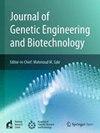Uracil walking primer PCR: An accurate and efficient genome-walking tool
IF 2.8
Q3 Biochemistry, Genetics and Molecular Biology
Journal of Genetic Engineering and Biotechnology
Pub Date : 2025-03-13
DOI:10.1016/j.jgeb.2025.100478
引用次数: 0
Abstract
Genome walking PCR has been extensively used to acquire unknown genomic regions bordering known DNAs. However, non-target amplification challenges the efficacy of existing genome-walking PCRs. Herein, we conceived a new genome-walking method termed Uracil walking Primer PCR (UP-PCR). The UP-PCR features introducing an uracil base at the penultimate position of arbitrary walking primer (AWP) 3′ end. A UP-PCR set comprises three nested amplification steps, which are performed by an AWP sequentially coupling a set of three nested site-specific primers, respectively. Prior to secondary UP-PCR, primary UP-PCR product is processed with uracil DNA glycosylase to destroy the carried AWP. As a result, only target primary product is exponentially amplified in the next UP-PCR(s), as it is the only product with binding sites for the both primers. The performance of UP-PCR has been validated by walking three selected genes. The walking experiments showed that each secondary or tertiary UP-PCR generated one to two amplicon ranging in size from 0.2 to 5.0 kb, while with a negligible non-target background; and the amplicons of the secondary UP-PCRs were all correct, indicating that tertiary UP-PCR is generally unnecessary. These findings suggested that UP-PCR has a satisfactory walking ability, specificity, and speed. Collectively, the proposed UP-PCR is a potential candidate method for genome walking.
尿嘧啶行走引物PCR:一种准确、高效的基因组行走工具
基因组行走PCR已广泛用于获取与已知dna相邻的未知基因组区域。然而,非靶标扩增对现有基因组行走pcr的有效性提出了挑战。在此,我们设想了一种新的基因组行走方法,称为尿嘧啶行走引物PCR (UP-PCR)。UP-PCR的特点是在任意游动引物(AWP) 3 '端倒数第二个位置引入尿嘧啶碱基。UP-PCR包括三个嵌套扩增步骤,分别由AWP依次耦合一组嵌套的三个位点特异性引物来完成。在二次UP-PCR之前,用尿嘧啶DNA糖基化酶处理一次UP-PCR产物以破坏携带的AWP。因此,只有目标初级产物在接下来的UP-PCR(s)中被指数扩增,因为它是唯一具有两种引物结合位点的产物。UP-PCR的性能已通过行走三个选定的基因得到验证。行走实验表明,每个二级或三级UP-PCR产生1 - 2个大小在0.2 - 5.0 kb之间的扩增子,而非目标背景可以忽略不计;二级UP-PCR扩增结果均正确,说明三级UP-PCR一般不需要。这些结果表明UP-PCR具有令人满意的步行能力、特异性和速度。总的来说,所提出的UP-PCR是基因组行走的潜在候选方法。
本文章由计算机程序翻译,如有差异,请以英文原文为准。
求助全文
约1分钟内获得全文
求助全文
来源期刊

Journal of Genetic Engineering and Biotechnology
Biochemistry, Genetics and Molecular Biology-Biotechnology
CiteScore
5.70
自引率
5.70%
发文量
159
审稿时长
16 weeks
期刊介绍:
Journal of genetic engineering and biotechnology is devoted to rapid publication of full-length research papers that leads to significant contribution in advancing knowledge in genetic engineering and biotechnology and provide novel perspectives in this research area. JGEB includes all major themes related to genetic engineering and recombinant DNA. The area of interest of JGEB includes but not restricted to: •Plant genetics •Animal genetics •Bacterial enzymes •Agricultural Biotechnology, •Biochemistry, •Biophysics, •Bioinformatics, •Environmental Biotechnology, •Industrial Biotechnology, •Microbial biotechnology, •Medical Biotechnology, •Bioenergy, Biosafety, •Biosecurity, •Bioethics, •GMOS, •Genomic, •Proteomic JGEB accepts
 求助内容:
求助内容: 应助结果提醒方式:
应助结果提醒方式:


